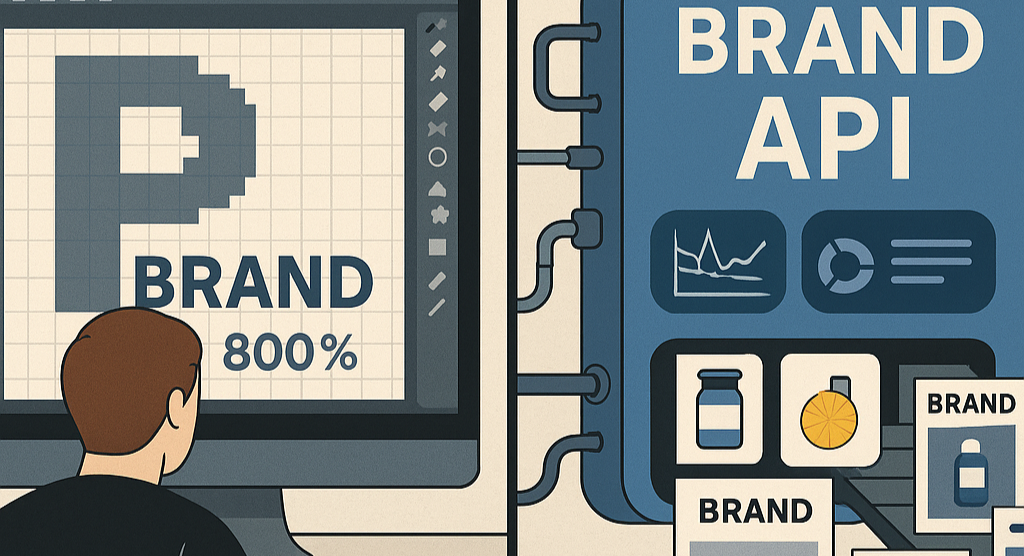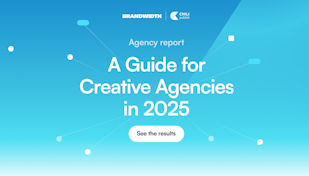The focus on pixel perfect is killing your brand

Last week I watched two designers argue for 20 minutes about whether the logo on a banner should move two pixels to the left. Two pixels. On a 1080-pixel wide canvas. That’s 0.18% of the space.
One of them actually zoomed in to 800% using Adobe’s magnification tool — a piece of software I’m convinced has ruined more marketing teams than bad CMOs. Suddenly the logo looked like a collection of Lego bricks, and the debate got serious.
Meanwhile, the client was on mute Googling “what is a pixel.”
By the time the file was exported, nobody remembered what the campaign was about. But hey, the logo was “pixel perfect.”
The cult of pixel perfect
Somewhere along the way, “pixel perfect” became a badge of honor. Agencies put it in decks, designers put it in bios, recruiters put it in job descriptions. It sounds scientific. Exact. Professional.
In reality, it’s dogma. It’s theatre.
Pixel perfect doesn’t mean “better marketing.” It means “you stared at a file long enough to find something microscopic to fix.” It’s the design version of arguing whether the parsley on the plate is crooked while the steak goes cold.
Adobe didn’t invent this obsession, but its magnification tool poured fuel on it. Once you can zoom in until individual pixels look like Minecraft blocks, it’s hard not to start moving them around. Suddenly a 2px misalignment feels like a scandal, even though no consumer in history has ever noticed it — or cared.
The brand book: theatre in PDF form
Agencies didn’t just adopt pixel perfection, they institutionalized it. Enter the brand book.
A 120-page PDF filled with rules: logo clear zones, exact Pantone numbers, minimum margins, typography hierarchies. Beautifully typeset, usually presented on stage with fanfare. Everyone applauds. The CMO feels reassured. The agency gets paid.
And then reality sets in. Six months later, nobody opens the PDF. Teams cut corners. Exceptions multiply. A new product line launches in another market and suddenly the 120-page brand book feels about as useful as an encyclopedia in the age of Google.
Except for the agency. They love the brand book, because it guarantees them a second revenue stream: brand police. Every campaign, every file, every execution needs to be reviewed “for compliance.”
Innovation stalls. Automation projects are blocked. A retail media team tries to generate Carrefour tiles and Walmart banners from one input — the agency says no, because “the book says the logo must sit 14px from the edge.”
That’s how pixel perfect and brand books conspire to keep brands slow, expensive, and dependent.
Do customers really care?
Let’s ask the only question that actually matters:
Has anyone in history bought more Coca-Cola, fewer Nikes, or switched from Dove to L’Oréal because the hero image on a shampoo ad was cropped 5 pixels tighter?
We both know the answer.
Customers don’t zoom in to 400%. They glance. They scroll. They notice story, tone, and relevance. They respond to availability, price, and timing. Nobody in the dairy aisle pauses to say: “I was going to buy this yogurt, but the kerning on the label is off.”
Pixel perfect is a tax brands pay to make agencies feel important. It doesn’t drive sales. It doesn’t drive loyalty. It doesn’t even drive consistency, because the PDF rules get broken in practice anyway.
The one place precision does matter is infrastructure: print bleed, file size, language compliance, retailer specs. Miss those, and you pay in reprints, rejected ads, or takedowns. But that’s infrastructure, not aesthetics.
Business reality in 2025
Now look at the world brands actually operate in:
- Retail media: Amazon wants white-background images. Walmart Connect uses in-grid tiles. Carrefour and Tesco have their own sponsored placements. Zalando needs fashion-ready banners. Specs change quarterly.
- Social platforms: TikTok pushes vertical 9:16. Instagram reels max out at 90 seconds. LinkedIn prefers horizontal 1.91:1. YouTube is now 50% Shorts.
- Print: Catalogues, POS displays, flyers. Miss a 3mm bleed, and you’re eating €50,000 in reprints.
Against this chaos, pixel perfect looks absurd. While you’re debating kerning, your campaign manager is drowning in a spreadsheet of 200 asset versions required for a single multi-market launch.
Pixel perfect is a distraction from the real problem: marketing has turned into a spec compliance nightmare.
From brand book to brand API
The answer isn’t another PDF. It’s an API.
Imagine if your brand rules weren’t text in a book, but code in a system:
- Fonts become tokens.
- Colors become variables.
- Margins become constraints.
- Disclaimers become mandatory, auto-applied layers.
- Language packs generate automatically.
Instead of pixel perfect, you get system perfect. Instead of brand police, you get brand execution.
A designer uploads one logo, one tagline, one product shot. The system generates 50 outputs across retail media, social, display, and print — all compliant by design. Nobody argues about 2px, because the system enforces what matters and ignores what doesn’t.
That’s a brand API.
Why agencies hate it
Agencies don’t hate brand APIs because they don’t work. They hate them because they work too well.
Pixel perfect keeps the invoice flowing. Every review, every correction, every late-night email about logo placement is billable time. A system that automates compliance wipes out that revenue.
That’s why agencies frame automation as “cookie cutter” or “dangerous to brand integrity.” It’s not dangerous. It’s disruptive — to their business model.
The irony is that brand APIs would free agencies to do what they’re actually good at: ideas, storytelling, campaigns. But as long as the incentive is to milk compliance, they’ll keep selling pixel perfect and PDFs.
The way forward
If creative is now infrastructure — and it is — then brand governance can’t live in a PDF. It has to live in code.
That doesn’t kill creativity. It kills the bottleneck. It frees humans from pixel-counting to focus on concepts, campaigns, and experiences that customers actually notice.
Agencies that adapt will thrive. They’ll sell ideas, not pixel policing. Brands that adopt APIs will scale across every channel faster, with fewer errors, at lower cost.
The rest will still be zooming in at 800%, debating Lego bricks.
Closing thought
Pixel perfect is killing your brand. Not because it makes the work bad — but because it makes the work slow.
Customers don’t see pixels. They see stories. They don’t care about a shampoo ad cropped 5 pixels tighter. They care about whether you’re relevant when they open TikTok, walk into Carrefour, or grab a flyer off a shelf.
A brand isn’t a book. It’s an API.
And the sooner we bury the cult of pixel perfect, the sooner we can get back to marketing.
CEO insights
Kevin Goeminne
Sep 24, 2025


